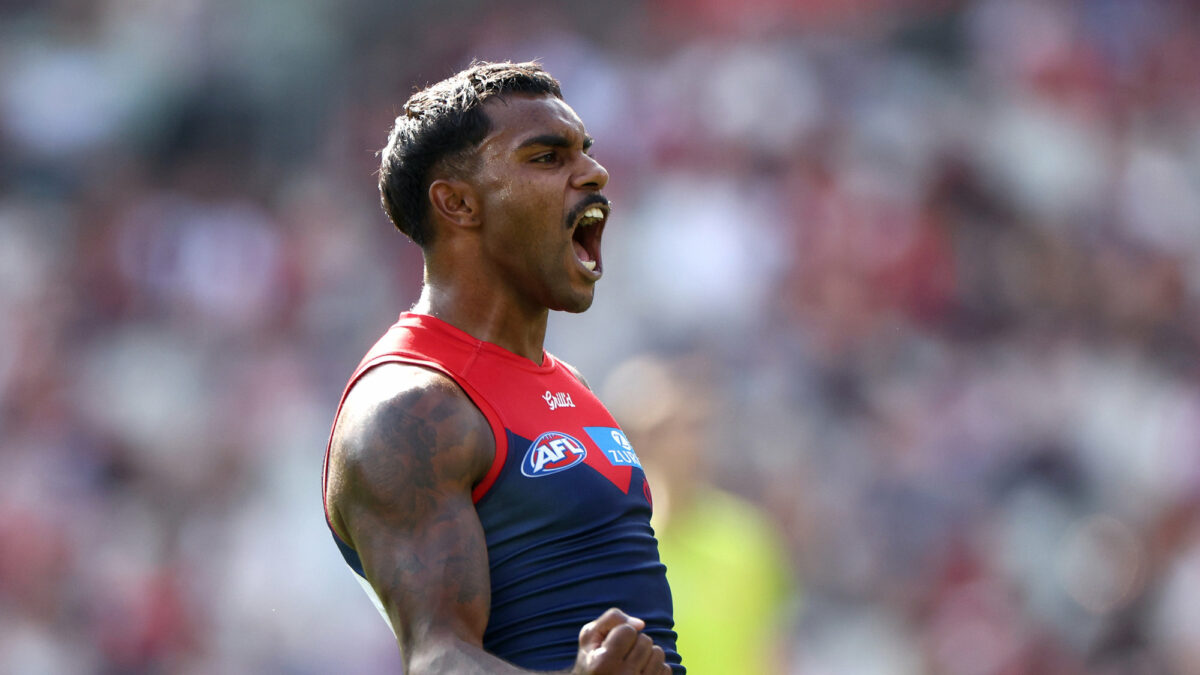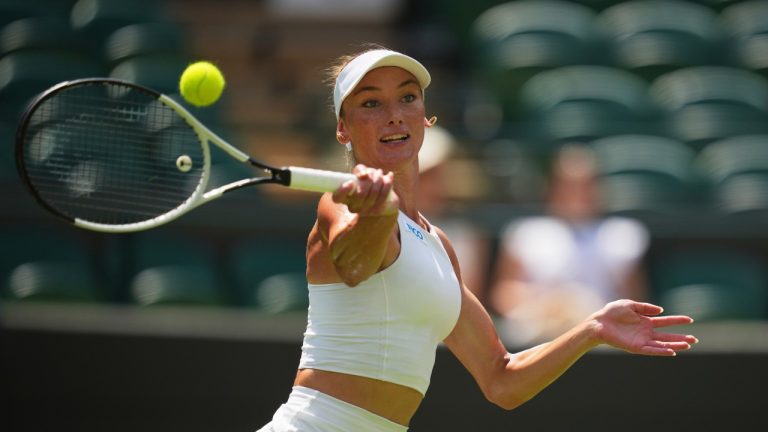You could see the relief etched into Simon Goodwin’s face.
You could see the delight on Max Gawn’s face at a first AFL win in eight months, in the jubiliation of Xavier Lindsay and Harvey Langford at a first senior win, in the cheers of supporters as the clock ticked down at the MCG with victory certain.
What the future holds is anyone’s guess – but for Melbourne right now, the present is pretty sweet.
The manner of the victory, officially by 10 points over Fremantle but spiritually as significant as any home-and-away Demons win since the 2021 premiership, would be just as gladdening to red and blue hearts as the joy of triumph itself.
A team which has been lifeless through the first five rounds, with an impotent forward line and wayward midfield combining to leave scoring at all like trying to get blood out of a stone, ripped an in-form finals contender to shreds with blistering run and carry, daring ball movement and a reinvigorated attack to equal their previous best effort this season before half time.
Who could possibly have seen it coming? This isn’t a return to the Melbourne powerhouse of yesteryear, the one which broke a 57-year flag drought and backed it up with successive top-four appearances on the back of a contested machine of a midfield and the stingiest defence known to man.
This was something new. Something fresh, innovative, exciting. Something at last up to speed with the way modern footy is being played.
Can it last? Maybe. Does it matter? Not right now. What’s indisputable is that a future that was looking as bleak as any team in the AFL at the start of the week now has the one thing every footy club needs: hope.
The radical makeover given to the forward line was the first indication that we’d see a different Demons this week.
Gone were Jacob van Rooyen and Bayley Fritsch, the former being suffocated by limited opportunities and monstered by opposition key backs whenever it came his way, the latter woefully out of touch and plagued by inaccuracy.
In their stead was Harrison Petty, rekindling an experiment trialled with disastrous results in 2024 and seemingly shelved for good, and former Lion Tom Fullarton, who couldn’t get a game last year even when he was the only fit ruckman on the list.
The idea, surely, was to be more competitive in the air and bring the ball to ground for the likes of Kysaiah Pickett (more on him later) and the youngsters to exert menace at ground level. On that metric, both passed with flying colours, with neither Alex Pearce nor Brennan Cox able to control proceedings in the air.
That the plan was working was evidenced by just four marks inside 50 to half time, and yet 11 goals – plus the small matter of an 11-1 tackle inside 50 differential. This was a match being won at ground level, a far more suitable method for the Dees with the tools they have to work with.
Petty, as it happened, kicked four goals in a tremendous game – but that scoreboard impact had more to do with the quality of ball coming his way. If he’d had this sort of delivery throughout 2024, perhaps he’d have fared better.
From centre bounces, the Dees were nothing short of explosive. With Jack Viney shutting down Caleb Serong – a task which appeared to rejuvenate the veteran after a tough start to the season – it seemed as if every time the Demons found a centre break, they capitalised on it.
Four of their 11 half time goals had come via centre bounces, after just seven across the first five rounds combined. There were even times when it resembled the famous Mad Minute from the 2021 grand final.
Look at the no-holds barred attack on the footy here, for instance.
It’s Pickett who dobs the goal, but he’s got both Petracca and Viney riding shotgun going inside 50 – when was the last time the Dees have been so menacing?
It means, instead of blasting long from 70 out, Pickett can sprint his way to 40 before shooting for home. Sometimes that extra 30 metres makes all the difference in the world.
It wasn’t even the first time, either: Viney’s goal in the first quarter followed a near-identical script.
As soon as Max Gawn wins the footy, Viney and Petracca are off to the races: notably as well, the Dees forwards’ first reaction is to start sprinting towards goal, leaving their Dockers opponents needing to decide whether to follow them or stay up and pressure the oncoming midfielders.
As it happens, it doesn’t matter: Viney sidesteps one with ease and kicks the goal anyway. But the set-up is completely antithetical to how the Dees have operated this season – and the improvement speaks for itself.
It’s a hell of a risky strategy, and indeed, the Dockers managed 97 points and 27 scoring shots going the other way. But at least a shootout gave the Dees a chance to thrill.
Not a single player was more well-suited to this approach than Pickett. Any analysis of this match needs him as its central character – no one this season in the AFL has had a better first half than his on Saturday.
Pickett’s role since returning from suspension has been in the Izak Rankine mould: start at centre bounces, and at the earliest opportunity, zip forward, and spend the majority of general play as a deep forward inside 50.
When on-ball, the Dees gave him all the cover he needed to attack the footy and weave through traffic; up forward, they did all they could to isolate him in space, knowing his speed on the lead would be a nightmare for any Dockers defender.
Aside from one Joe the Goose goal gifted to him on a platter by Petty, this was how Pickett ripped the game apart with four first-half goals. The delivery didn’t even have to be good for him to dominate – just put it in his vicinity, structure up in attack to allow for open space, and let him work his magic.
It took Freo way too long, as well, to realise how dangerous he could be when given a run and jump at the footy.
Isolating him turned out to be far more effective than when it was van Rooyen or Fritsch as the deepest option; for one thing, it messed with Freo’s defensive structure, with Pearce and Cox not wanting a bar of being one-out with Pickett inside 50 and pulled further away from their usual zones by Fullarton and Petty.
And for another, he’s deceptively strong as well as quick, so is just about the most dangerous out the back player the Dees have to work with.
There are, of course, pitfalls to this new, all-out attacking Melbourne: Freo, despite Josh Treacy being brilliantly held by Tom McDonald, seldom found it tough to score, and as a result stayed within touching distance all match and even threatened to pinch it deep into the final quarter.
Defensive running was at a disadvantage given how intent Viney and Petracca in particular were in getting forward of stoppages – Viney in particular wasn’t quick to begin with. Against Andrew Brayshaw in particular, that presented problems when the Dockers got going.
But you know what? It was worth the risk. And – and here’s the key – putting a triple-figure score on the board felt sustainable in a way that would have been unthinkable mere days ago. There’s no reason why this strategy can’t become a workable gameplan, certainly against Richmond and West Coast in the next fortnight.
From team selection to use of Pickett to his gung-ho approach, Goodwin pulled every rein right on Saturday afternoon.
The result was a win his club – and he himself – needed as badly as any in his time at the helm. Only time will tell, but he just might have saved Melbourne’s season.






